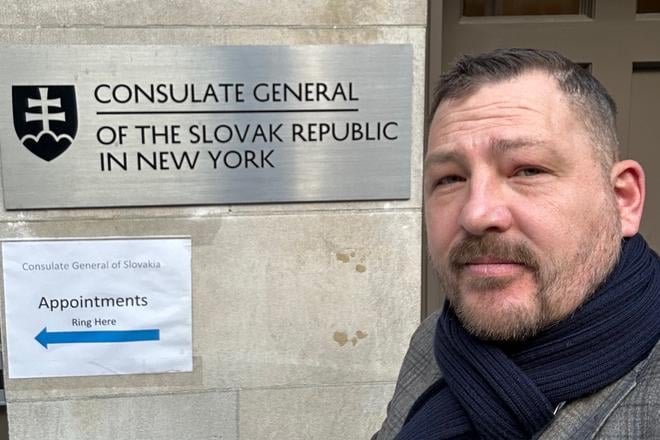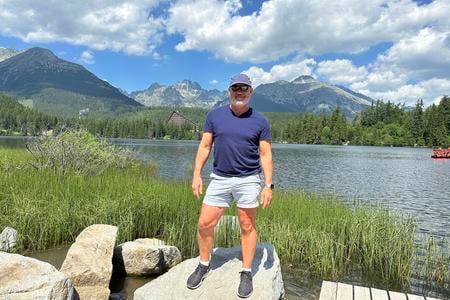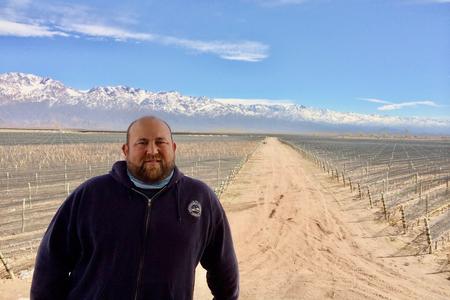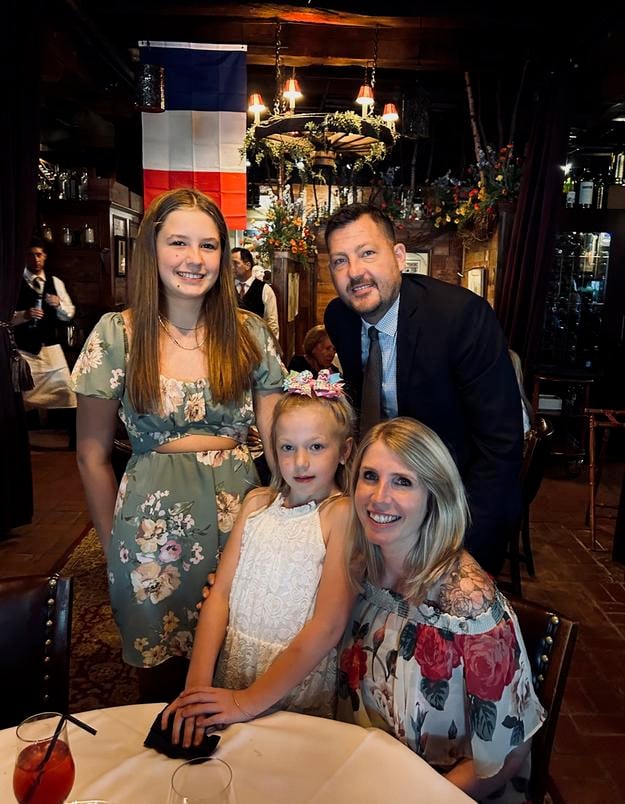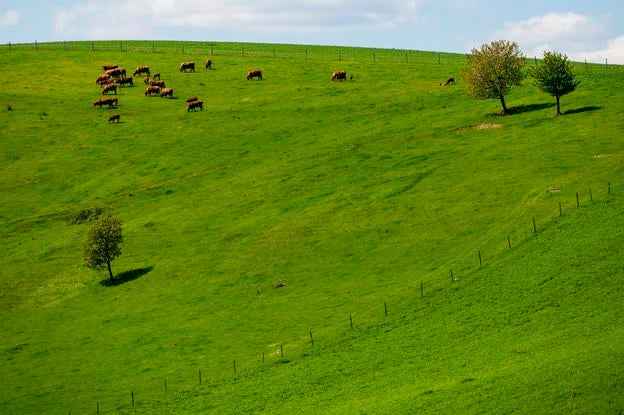You can read this exclusive content thanks to the FALATH & PARTNERS law firm, which assists American people with Slovak roots in obtaining Slovak citizenship and reconnecting them with the land of their ancestors.
Growing up, Slovak American Benjamin Demko never quite felt like he fully belonged. Not to the Slovak community, despite being surrounded by the culture, festivals, foods, and church, but not completely to American life either. There was a kind of quiet distance on both sides.
"I didn't speak Slovak, but I was also different than a lot of the kids I grew up with because either their ancestors were from different parts of Europe, or had been in the United States for generations," he says, adding that it was almost like trying to balance between two different worlds with him in the middle. This feeling floating between two worlds eventually played a big part in Demko's seeking Slovak citizenship when the government allowed it in 2022. He wanted to reconnect, understand, and claim something he knew he had.
There was a lot he had come to like about Europe when he had travelled around in his thirties: the culture, the languages, the ease of movement, the history. Back then, Slovakia didn't offer citizenship, but it was still on his mind.
"And then I learned that the government passed this bill and I was ecstatic. The minute I heard, I started getting all my paperwork together," he recollects.
Breaking a cycle
Demko's great-grandfather, Andrew Demko, was born in 1892 in Šarišské Michaľany, a small village in the Sabinov district in eastern Slovakia. His parents, Štefan Demko and Zuzana Demková (neé Vanyová), lived what he can only imagine was a difficult life of peasantry.
With pretty much no prospects in Slovakia, in 1910 at just 18 or 19, Andrew made the journey across the Atlantic to the United States, little money in his pockets and, as usual, not knowing the language. Like many immigrants, his hope was to earn enough money working, send it back home, and return someday. He ended up in a tiny coal mining town in Pennsylvania called Sagamore—one of many places filled with Slovak immigrants chasing the same dream.
Andrew worked in the coal mines for years. It was a gruelling, dangerous, and unfortunately exploitative job. The mining company paid workers not in cash, but in vouchers redeemable only at the company store. The company controlled everything, including housing and goods. However, there he met his wife Katherine Pachan. They married in 1913 at Saints Peter and Paul Byzantine Catholic Church in Punxsutawney, Pennsylvania and proceeded to have six children, with Demko's grandfather, Stephen Andrew, the only boy.
But the situation for workers worsened, and tensions escalated. People began organising and unionising. Eventually, Andrew and the family moved to Lorain, Ohio, near Cleveland, where they knew several Slovak families. There was also a steel mill and the chance of a better life.
Steel work in the 1930s and 40s meant a step up. It wasn't easy work, but it paid enough to support a family. For a man who didn't speak English and had no formal education, it was a path forward. Andrew worked there for the rest of his life. Demko's grandfather followed suit after finishing school, and so did his father Stephen Michael—though only for a time. His father broke the cycle and went to college, became a teacher, eventually a school principal.
Lorain was a true melting pot. Slovaks, Romanians, Italians, Poles—all these communities lived side by side. At the centre of the Slovak community was Holy Trinity Church, and a Slovak club that still stands to this day.
"I go there quite a bit. They've got a little bowling alley, bar, things like that. I remember going there as a kid and everybody was speaking Slovak," he recollects.
Learning the language
Yet, despite all this, Demko's father never learned the Slovak language. His parents, like so many immigrant families, wanted their children to fit in, to be American. It's a decision Demko understands, but at the same time feels saddened by it; he would have loved the opportunity to learn Slovak. Demko muses that they probably thought he didn't care. Slovak was not pushed, but neither discouraged. In the end, it was something he had to pursue himself. Thanks to the organisation of Global Slovakia, he started taking lessons. Unfortunately, after about a semester he stopped because work got in the way – he is an economist at a bank.
"I continue to study on my own with an app and I also have books called Colloquial Slovak and Krížom Krážom. It's my goal to learn the language," he says, reasoning that if granted citizenship, he would like to become a part of the country and maybe move to Slovakia at least part time.
What was actually passed down to Demko were the stories of their home in Slovakia.
"When I was a kid, I just remember hearing the stories that were passed down to my grandparents, learning about Slovakia, looking it up in in books. The pictures looked so beautiful to me, the mountains and farms. I remember asking myself why would they leave that place to come to Lorain, which was more of a manufacturing town," he says, adding that once he learned the history, he understood. At the same time, they never forgot about their origins and were very proud of it.
"Hearing about and imagining these experiences instilled in me a deep connection and nostalgia for Slovakia that only grows stronger as I get older."
Also, interestingly, Demko remembers his grandparents being very superstitious about a lot of things.
"My uncle told me that when he was small, he had a wart on his chin and my grandmother took him out in the moonlight, kept putting a knife to it and said some spell. He was scared. They were old school kind of people," he explains, adding that similarly, when his great-grandmother died, his mother wasn't allowed to go to the funeral because she was pregnant with him. It was believed that if she looked upon a dead body, her baby would be cursed.
Discovering history
The journey to citizenship hasn't been quick. It's taken about two years just to gather the paperwork. One of the biggest challenges was not getting the great-grandfather's birth record in Slovakia - Demko found a genealogist who was able to track it down very quickly - it was getting documents related to his grandfather that proved difficult.
The mining town he was born in has long since vanished, as has the church he was baptised in. Demko had to dig around extensively, but eventually discovered that the records had been transferred to another Byzantine Catholic Church in a different town.
Meanwhile, the genealogist in Slovakia was able to trace his family back five generations. The report was eye-opening—his great-great-grandparents had ten children, of which only two survived. The others were lost to illness and poverty, the brutal realities of the time.
"I've learned so much about my family and particularly my great-grandparents, who I didn't know as I was too young," he says, adding that he has already received his Slovak Living Abroad certificate and residency permit. The citizenship application is in, and he's waiting for the final decision.
Demko has a brother, but just like many others in this situation, the latter doesn't share what Demko calls an "obsession". At the moment, his brother is waiting to see what happens. The brother is five years younger and wasn't as immersed in the Slovak side growing up. However, Demko believes that if he gets citizenship, his brother might follow suit. For now, the brother is just happy letting Demko do the legwork.
As for his ancestors, Demko says he doesn't think they would have ever imagined him trying to re-discover his roots and applying for citizenship in Slovakia. Despite being proud of their ancestry, they wanted to be part of America.
"If they had been here right now and I was talking to them about it, they would probably be surprised. They would probably be like, why would you want to do that? But I'm a different generation. I love Europe so much. I love the history. I love the people. I love learning about different cultures and the foods," he says.
Although Demko hasn't visited Slovakia yet, he has used Google Street View to "walk" through the villages of his ancestors. Since he himself is an outdoorsman and does camping, hiking, backpacking in the US, he would relish the opportunity to do the same in Slovakia.
"I'm really hopeful I can come and spend an extended period to really explore some of the natural parks and and things like that," he says, adding that in June the whole family is planning a trip to Slovakia and everyone is very excited to spend more time in the country.
Curious to try halušky
In addition to nature, Demko is also curious how some dishes will taste. A lot of the traditions that he remembers are centred around food, Christmas time in particular, which he came to know as the Vilija, which is a dialect word from the historic Šariš region in eastern Slovakia.
"Although my parents and grandparents are now gone, I try to keep the spirit alive through sharing oplátky with family and friends, and preparing holúbky (stuffed cabbage rolls), pirohy, makovník (poppy seed roll) and orechovník (walnut roll)," he says. Before his grandmother died, she taught him her way to make halušky, and his brother how to make kurací paprikáš (chicken paprikash). But when he had the latter in Hungary, it was different than what his grandmother made.
"Because, you know, when they came to the US, they had different ingredients. So when I grew up eating halušky, it was usually with cabbage, garlic, salt, dumplings or egg noodles, some cheese or sour cream, some bacon on top. That's how she would make it, that's how she taught me to make it," he explains, adding that his family used a lot of feta cheese, maybe because it was the closest thing to bryndza they could get their hands on.
"I'm very curious when I come to Slovakia and try halušky. I'm guessing it could be totally different," he says.
"In many ways it is and has been an intense journey of nostalgia and emotional connection," he concludes.
Spectacular Slovakia travel guides
A helping hand in the heart of Europe thanks to our Slovakia travel guide with more than 1,000 photos and hundred of tourist spots.
Our detailed travel guide to the Tatras introduces you to the whole region around the Tatra mountains, including attractions on the Polish side.
Lost in Bratislava? Impossible with our City Guide!
See some selected travel articles, podcasts, and traveller info as well as other guides dedicated to Nitra, Trenčín Region, Trnava Region and Žilina Region.


